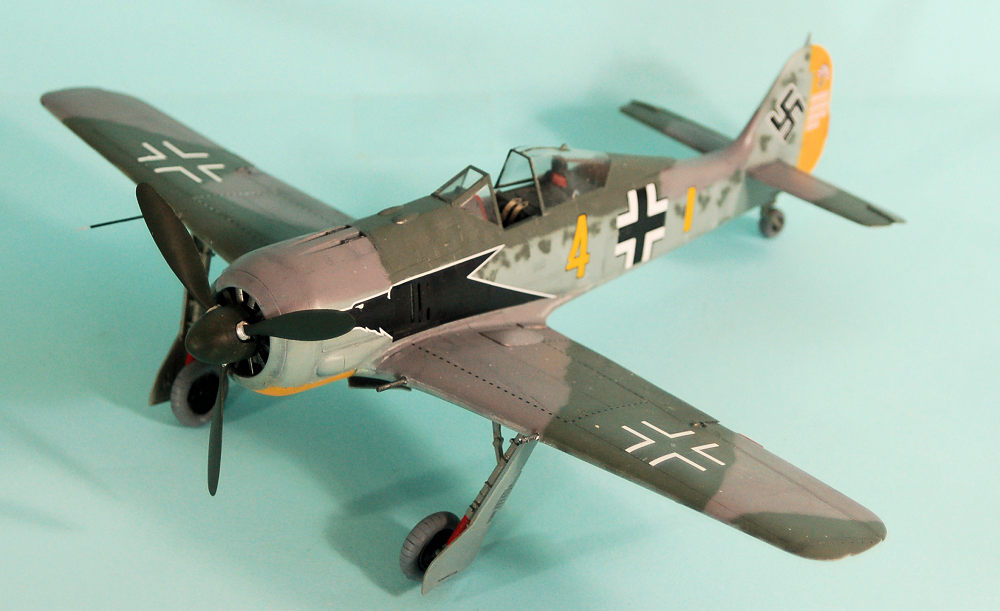
PCM 1/32 FW-190A-4
| KIT #: | PCM 32011A4 |
| PRICE: | $74.95 MSRP |
| DECALS: | 8 options for the A-4 and another 8 for the A-1/2/3 |
| REVIEWER: | Tom Cleaver |
| NOTES: | Short run kit |

| HISTORY |
1942 could be called “the year of the Wurger.” While only 224 Fw-190As had been accepted by the Luftwaffe by the end of 1941, 1,878 would be produced at three different factories during 1942, the third being the Fieseler plant at Kassel that began production in May 1942.
The last of the early “short-nose” Focke-Wolf fighters, the Fw 190A 4 was introduced on the production lines over the summer of 1942. This sub-type differed from the preceding Fw-190A-3 by being equipped with the MW 50 power boost system to obtain additional power below the rated altitude of the BMW 801D-2 engine. By injecting a water methanol mixture into the cylinders, the engine could briefly sustain a compression over the redline and get a little more horsepower. Beyond this, the only real visual difference from the A 3 was that the A 4 added a short radio antenna atop the vertical fin. The Fw-190A-4 was the most-produced sub-type of the early Fw-190s.
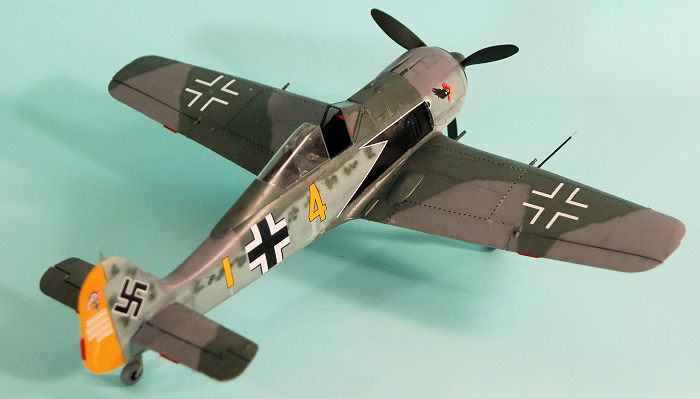 The
Fw-190A-4 dominated air combat on the Channel Front until the summer of 1943.
Even the hurried introduction of the new Supermarine Spitfire Ixc beginning in
July 1942 did little to redress the balance; the Spitfire IX with its Merlin-60
series engine with two-stage blower just brought the Spitfire up to a position
of relative equality with the Fw-190. The two were so evenly-matched that Johnny
Johnson, eventually the leading ace in the Spitfire IX, said that the outcome of
combat between the two was entirely dependent on pilot skill.
The
Fw-190A-4 dominated air combat on the Channel Front until the summer of 1943.
Even the hurried introduction of the new Supermarine Spitfire Ixc beginning in
July 1942 did little to redress the balance; the Spitfire IX with its Merlin-60
series engine with two-stage blower just brought the Spitfire up to a position
of relative equality with the Fw-190. The two were so evenly-matched that Johnny
Johnson, eventually the leading ace in the Spitfire IX, said that the outcome of
combat between the two was entirely dependent on pilot skill.
Only three Geschwadern were left on the Channel Front: JG 26 was left in northern France with JG 2 on the Brittany Peninsula and JG 1 in Holland after the transfer of Luftwaffe units to the east to take part in Case Barbarossa in the summer of 1941. With a maximum of around 150 aircraft, primarily Fw-190s though some Bf-109Gs began appearing in the summer of 1942 to provide better high altitude capability, these three Jagdgeschwadern kept the Allies essentially at bay on the Channel Front until the summer of 1943 when units of the 8th Air Force began to appear in greater numbers.
Siegfried Schnell:
Born in 1916 in the state of Brandenburg, Siegfried Schnell joined the
National Socialist Flying Clubs in 1933 and soon demonstrated a natural skill as
a glider pilot. He joined the Luftwaffe in 1936 and was a Feldwebel with 4./JG 2
by the outbreak of war in September 1939. JG 2 remained in the West, and Schnell
did not see combat until the Blitzkrieg of May 1940. His first victory was a
French MB.152, shot down on
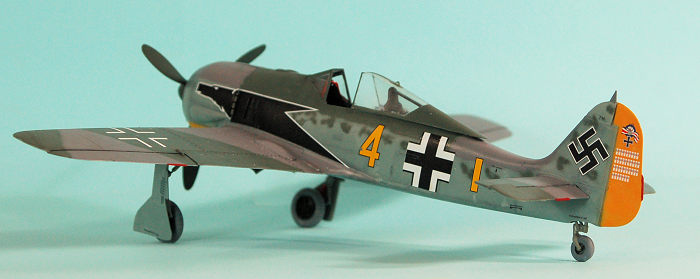 May 14.
His star began to rise during the Battle of Britain and he scored regularly. By
November he was commissioned a Leutnant, and scored his 20th victory on November
7 off the Isle of Wight, for which achievement he was awarded the Knight’s Cross
later that month. Throughout the spring of 1941 he continued to score against
the RAF during the “Non-Stop Offensive.” On June 24, 1941, he was appointed
Staffelkapitän of 9./JG 2. Over July 8-9 he shot down nine Spitfires - a
considerable achievement in the Bf-109F - to reach his 44th victory making him
one of the top pilots in JG 2, and was immediately awarded the Knight’s Cross
with Oak Leaves; at the time he was one of the leading experten of the
Geschwader.
May 14.
His star began to rise during the Battle of Britain and he scored regularly. By
November he was commissioned a Leutnant, and scored his 20th victory on November
7 off the Isle of Wight, for which achievement he was awarded the Knight’s Cross
later that month. Throughout the spring of 1941 he continued to score against
the RAF during the “Non-Stop Offensive.” On June 24, 1941, he was appointed
Staffelkapitän of 9./JG 2. Over July 8-9 he shot down nine Spitfires - a
considerable achievement in the Bf-109F - to reach his 44th victory making him
one of the top pilots in JG 2, and was immediately awarded the Knight’s Cross
with Oak Leaves; at the time he was one of the leading experten of the
Geschwader.
JG 2 equipped with the Fw-190A shortly after JG 26. Schnell was given temporary command of III/JG 2 from December 9, 1941 to January 28, 1942 while Gruppenkommandeur Hans "Assi" Hahn was on leave. He scored his 52nd victory on February 12, 1942 while providing cover for the Scharnhorst, Gneisenau and Prinz Eugen in the “Channel Dash.” During the day-long air battles over Dieppe on August 19, 1942, he shot down five Spitfires during three missions to reach his 71st victory.
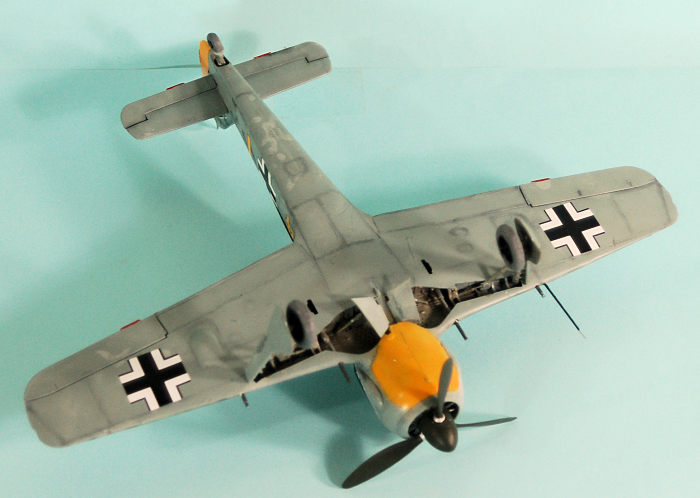 In
the spring of 1943, the Luftwaffe came up with the ill-conceived idea of
rotating fighter units between the Eastern and Western Fronts, despite the very
different combat conditions that existed on each. III/JG 54 was transferred to
the West in May 1943 and Schnell, now with 80 victories, was appointed
Gruppenkommandeur. He spent most of the summer training the pilots in the high
altitude combat they would face against the 8th Air Force, re-entering combat in
time to take part in opposing the Scheweinfurt-Regensburg Mission and the bitter
battles that fall which culminated in the Schweinfurt Raid of October 14, 1943
in which the Luftwaffe put paid to the USAAF’s strategy of unescorted
deep-penetration daylight bomber raids. On January 11, 1944, during the 8th Air
Force mission against Oschersleben, Schnell shot down three B-17s for his 88th,
89th, and 90th victories.
In
the spring of 1943, the Luftwaffe came up with the ill-conceived idea of
rotating fighter units between the Eastern and Western Fronts, despite the very
different combat conditions that existed on each. III/JG 54 was transferred to
the West in May 1943 and Schnell, now with 80 victories, was appointed
Gruppenkommandeur. He spent most of the summer training the pilots in the high
altitude combat they would face against the 8th Air Force, re-entering combat in
time to take part in opposing the Scheweinfurt-Regensburg Mission and the bitter
battles that fall which culminated in the Schweinfurt Raid of October 14, 1943
in which the Luftwaffe put paid to the USAAF’s strategy of unescorted
deep-penetration daylight bomber raids. On January 11, 1944, during the 8th Air
Force mission against Oschersleben, Schnell shot down three B-17s for his 88th,
89th, and 90th victories.
On February 1, Schnell was given orders to the Eastern Front, taking command of IV/JG 54 outside Leningrad on February 11, 1944. Flying the Bf-109G-6, he scored three victories over the next twelve days but failed to adapt to conditions on the Eastern Front. He was shot down and killed on February 25, 1944, during the Soviet offensive against Narva. He had flown over 500 combat missions and ended with 93 confirmed victories, including 12 B-17s, making him one of the Luftwaffe’s top bomber-killers. His tally of 90 on the Western Front made him the 11th ranking German experte over the Western Allies.
| THE KIT |
The arrival of this kit announces the news that Pacific Coast Models is back in business. When Ken Lawrence announced last year that he was closing Pacific Coast Hobbies to retire, it looked like that was the end of kits from this source. However, PCH was purchased earlier this year by Loic Anthian, who ran Great Models, and it is now running as Kitlinx.com. A decision has been made to continue kit releases in the Pacific Coast Models brand.
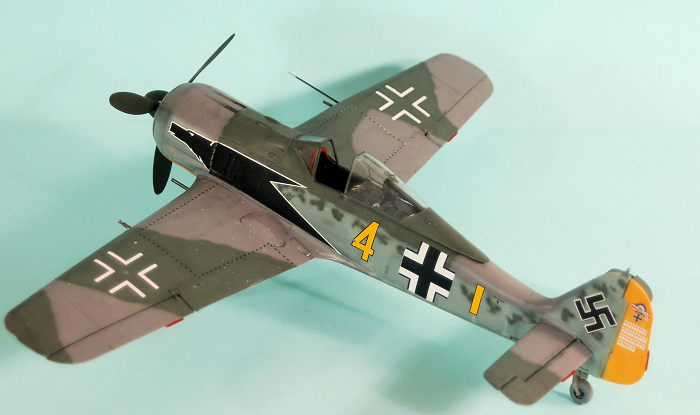 This
kit is basically the previous Fw-190A-1/A-2/A-3 kit released in 2010, with resin
parts included now to cater to changes associated with the Fw-190A-4, primarily
a new vertical fin tip with the different antenna mast, as well as a part to
change the exhaust cooling area to the flaps of the later versions beginning
with the A-4. A decal sheet is included with markings instructions for six
Fw-190A-4s; the markings instructions and decals for the previous release are
also included, providing a modeler with the option of doing any Fw-190A from the
A-1 through the A-4.
This
kit is basically the previous Fw-190A-1/A-2/A-3 kit released in 2010, with resin
parts included now to cater to changes associated with the Fw-190A-4, primarily
a new vertical fin tip with the different antenna mast, as well as a part to
change the exhaust cooling area to the flaps of the later versions beginning
with the A-4. A decal sheet is included with markings instructions for six
Fw-190A-4s; the markings instructions and decals for the previous release are
also included, providing a modeler with the option of doing any Fw-190A from the
A-1 through the A-4.
The resin exhaust part requires one to cut open the fuselage and remove the previous section, to be replaced with the resin part. I am not sure how well this is going to work out, which is why I chose to do Schnell’s airplane, which was an early A-4 with the same exhaust cooling as the earlier versions. Unlike the A-1 to A-3 versions, the A-4 included MW 50, which means one must also scribe the circular panel in the lower fuselage aft of the wing associated with that system (which I neglected to do here).
| CONSTRUCTION |
The kit differs from the Hasegawa kits in that the inner gear doors are molded shut, and the flaps are molded in the closed position. This is not really accurate for the inner gear doors, which opened and closed in a manner similar to the P-51 Mustang - lowering to allow the gear to come down, then either partially closing or remaining down. I cut these off the lower wing for later installation in a more accurate position.
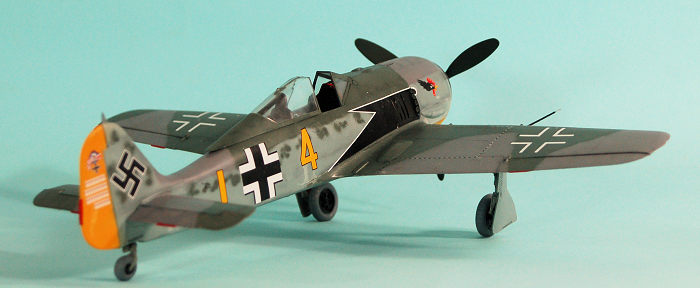 The
very nice resin cockpit caters to the cockpit of the early version, which
differs in minor detail from the Fw-190A-4; however, most people don’t know
these differences and the fact that virtually none of the cockpit is seen once
the model is assembled puts this in the “don’t worry about it” category. The
instrument panel is a pre-painted photo-etch “sandwich” from Eduard, and the
seatbelts are a pre-painted simplified set from Eduard.
The
very nice resin cockpit caters to the cockpit of the early version, which
differs in minor detail from the Fw-190A-4; however, most people don’t know
these differences and the fact that virtually none of the cockpit is seen once
the model is assembled puts this in the “don’t worry about it” category. The
instrument panel is a pre-painted photo-etch “sandwich” from Eduard, and the
seatbelts are a pre-painted simplified set from Eduard.
The wheel well is one-piece resin, which fits easily where it should if you sand down the upper leading edge of the part so the leading edge of the upper and lower wing will come together. Care in gluing this part in position will insure proper dihedral.
As with the earlier PCM kit, one needs to clean off some flash. Other than that, everything fits nicely, though you will use filler on all the seams since it is a limited-run kit. Just remember the rule for limited-run kits: fit thrice before gluing once.
| COLORS & MARKINGS |
 The
model was finished with my Tamiya paint mixes for RLM 74, 75, 76, applied
freehand.
The
model was finished with my Tamiya paint mixes for RLM 74, 75, 76, applied
freehand.
The kit decals are excellent and went down without problem under an application of Solvaset.
I attached the landing gear, unmasked the canopy and glued it in the open position. I tried to bend it in so it attached like the actual canopy, but the plastic is a bit brittle and I decided not to press my luck and break it.
| CONCLUSIONS |
This is the only kit in this scale that gives the 1/32 modeler the option of doing the early “short nose” Fw-190As. The likelihood of Hasegawa making a mold for a separate fuselage is somewhere between slim and non-existent (it is possible to convert a Hasegawa Fw-190A-5 to an A-4, but the problem of doing that starts with finding a kit that isn’t being sold for megabucks by a collector). I am sure if you take your time that the resin part for the later A-4 exhaust will work. Recommended for modelers with experience working with limited-run kits.
28 June 2018
Copyright ModelingMadness.com
Review kit courtesy Pacific Coast Models. Get yours at Kitlinx.com
If you would like your product reviewed fairly and fairly quickly, please contact the editor or see other details in the Note to Contributors.
Back to the Main Page Back to the Review Index Page Back to the Previews Index Page